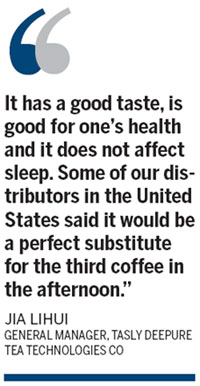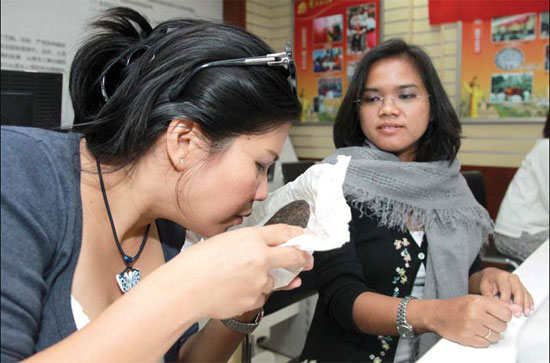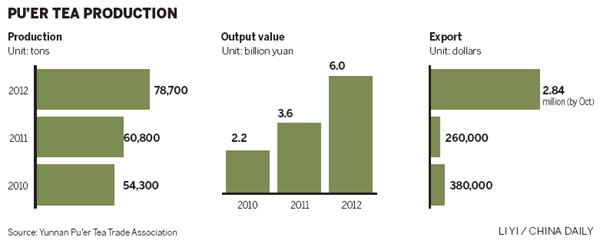Brewing up an international brand
Updated: 2013-01-14 05:50
By Xie Yu and Guo Anfei in Pu'er (China Daily)
|
||||||||
It is a conventional wisdom among Chinese people that after a heavy meal, a cup of Pu'er tea will help to cut the grease and remove excessive fat from the body.
|
A woman checking the quality of Pu'er tea in Pu'er city, in Southwest China's Yunnan province. Many people find that the taste, fragrance and health benefits of Pu'er get better after it matures. It is believed to have a strong effect in helping people lose weight and lower blood fat and sugar levels. Wang Haixin / For China Daily |
Now China's giant medical group Tasly has taken the ambitious step of trying to make it "the third coffee" for people in the West.
"It has a good taste, is good for one's health and it does not affect sleep. Some of our distributors in the United States said it would be a perfect substitute for the third coffee in the afternoon," said Jia Lihui, general manager of Tasly Deepure Tea Technologies Co.
The company is wrapping up the construction of a huge manufacturing base in Pu'er city, in Southwest China's Yunnan province, with an output capacity of 1,000 tons of tea a year.
 |
Traditional Pu'er tea is made into biscuits or bricks, which need to be broken before being mixed with hot water and drunk. Hundreds of years ago traders would travel thousands of miles on the ancient Tea-Horse Road (chamagudao in Chinese), to transport Pu'er tea to Tibet and Southeast Asia. It became a vital drink for Tibetans who had little fruit and vegetable in their daily diet to decrease lipids in the blood and fight arteriosclerosis.
Pu'er city, the starting point of the ancient Tea-Horse Road, is also the home of Pu'er tea.
Pu'er is a special kind of tea grown in southern Yunnan. The tea is so well known that the local authorities decided five years ago to change the name of their hometown from Simao to Pu'er.
Tasly uses modern extraction processes to make highly purified Puer tea extract and completely remove any possible heavy metals, pesticide residues and foreign substances.
"Based on Pu'er's effective function in lowering lipid levels, helping weight loss and reducing blood pressure, we want to make Pu'er tea a kind of fast-moving consumer good. We expect a lot from the overseas market, especially the US," said Jia.
Tasly's subsidiary company in the US is preparing for Food and Drug Administration's tests so it can start to promote the product widely.
"If we succeed, we would be ushering in a new era of Pu'er tea, an ancient crop that has grown on this land for thousands of years," said Liu Lun, deputy director of the Tea Bureau in Pu'er city.
According to He Jitang, owner of Longsheng Pu'er Tea factory, while the drought has made the leaves thinner, weaker and less attractive, it has also made the quality better because the picking was delayed and, therefore, the spring tea had time to gather more strength.
Zhang Baosan, president of the Yunnan Pu'er Tea Trade Association, said many people find that the taste, fragrance and health benefits of Pu'er get better after it matures.
"Pu'er tea used to be matured naturally while being transported on horseback from Yunnan to Tibet," Zhang said. "But now that maturing process can be controlled and standardized."
Pu'er is a big-leaf tea produced in Yunnan, especially in the Pu'er, Lincang, and Xishuangbanna areas. Records show it was drunk as long ago as the Eastern Han Dynasty (AD 25-220). The tea is commonly packaged as a cake, brick or lump, to make storing and transportation convenient.
The price of Pu'er tea leaves, which were given as a tribute to the imperial court during the Qing Dynasty (1644-1911), rose more than 500 yuan ($80.26) a kilogram on average, having been 20 yuan a kg in 2007. It has since fallen back.
One day you could exchange a pack of tea leaves at the market for a motorcycle then the next day it was worth nothing. That's how the market fluctuated, Liu said.
"After that we realized it won't help if we just improve output because it is not the quantity that decides the price but the quality," he added.
Almost half of the tea trees were grubbed up to give more space and nutrients to those saved.
"We reviewed the ancient planting methods and conducted experiments to find the optimal space between two trees and then persuaded the tea planters to adjust their over-densely planted tea gardens," Liu said.
Related readings
White tea lifts Guizhou county out of poverty

 Li Na on Time cover, makes influential 100 list
Li Na on Time cover, makes influential 100 list
 FBI releases photos of 2 Boston bombings suspects
FBI releases photos of 2 Boston bombings suspects
 World's wackiest hairstyles
World's wackiest hairstyles
 Sandstorms strike Northwest China
Sandstorms strike Northwest China
 Never-seen photos of Madonna on display
Never-seen photos of Madonna on display
 H7N9 outbreak linked to waterfowl migration
H7N9 outbreak linked to waterfowl migration
 Dozens feared dead in Texas plant blast
Dozens feared dead in Texas plant blast
 Venezuelan court rules out manual votes counting
Venezuelan court rules out manual votes counting
Most Viewed
Editor's Picks

|

|

|

|

|

|
Today's Top News
Boston bombing suspect reported cornered on boat
7.0-magnitude quake hits Sichuan
Cross-talk artist helps to spread the word
'Green' awareness levels drop in Beijing
Palace Museum spruces up
First couple on Time's list of most influential
H7N9 flu transmission studied
Trading channels 'need to broaden'
US Weekly

|

|









